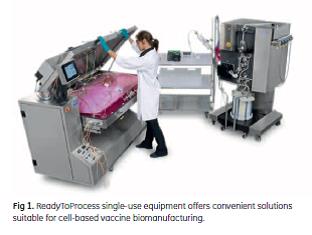 The aim of this white paper is to demonstrate how Cytiva single-use products can be applied in the field of vaccine manufacturing.
The aim of this white paper is to demonstrate how Cytiva single-use products can be applied in the field of vaccine manufacturing.  The white paper includes a brief discussion around modern vaccine processes, followed by a case study showing the scale-up of upstream and downstream processes for the production of a cell based live attenuated influenza virus using single-use ReadyToProcess technology (Fig 1).
The white paper includes a brief discussion around modern vaccine processes, followed by a case study showing the scale-up of upstream and downstream processes for the production of a cell based live attenuated influenza virus using single-use ReadyToProcess technology (Fig 1).
Introduction
Egg-based production is the most commonly used technique for manufacturing of influenza vaccine. This technique has its limitation in that it requires one fertilized egg per produced vaccine dose. The objective of WHO’s global action plan (GAP) for influenza vaccines is to produce enough seasonal flu vaccine to immunize two billion people by 2015 (1). If facing a pandemic, the world would need more than 13 billion doses to protect a naïve population with two immunizations. To put that in perspective, in 2011, 25 of the world’s leading vaccine manufacturers produced 620 million doses (2). There is a clear need to produce more doses in a shorter time frame. Cell-based vaccine production with well-characterized processes can be a solution to meeting the capacity requirements. It also has its advantage in shorter production time compared to egg-based production, allowing for an improved ability to more rapidly meet the seasonal strains.
There are three different types of flu vaccines on the market: split virus, subunit vaccines, and live attenuated. Live, attenuated influenza vaccine (LAIV) requires less virus particles per vaccine dose. This translates into more doses per production volume and can thus, to some extent, compensate for the lack in production capacity.
Several of the vaccines we consider to be the base in today’s Western immunization programs have not yet reached the developing world as there are many barriers to overcome, such as production cost, logistics, and production capacity. Diseases, such as Haemophilus influenza B (HiB), Japanese encephalitis (JE), rotavirus, and pneumococcal infections, are targets for the developing world to save millions of children’s lives. Hence, there is a continuing need to develop existing vaccine manufacturing processes in order to improve access for developing markets, for faster responses to the vaccine needs, and to increase the number of doses produced.